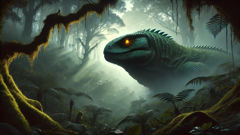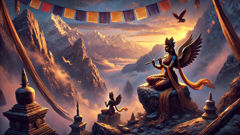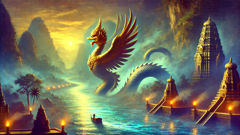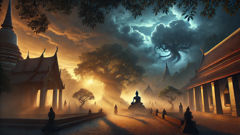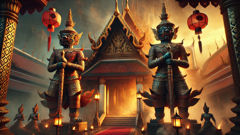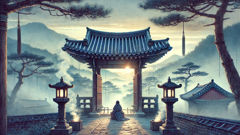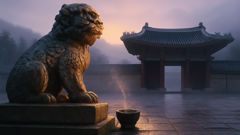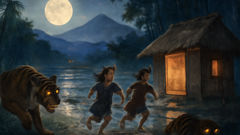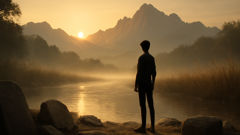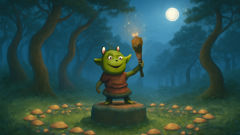Introduction
Long before the songs of birds drifted over Aotearoa’s ancient forests and the laughter of people echoed through her valleys, a vast and shadowy presence moved through the land. In the mists of prehistory, when the mountains rose jagged and sharp from the earth and dense ferns unfurled beneath dripping canopy, the world was watched over by beings whose names now linger only in whispered tales. Among these, none inspired more awe or dread than the Kumi—a creature of unimaginable size, the color of ancient stone, with scales that glimmered like rain-wet pounamu and eyes that seemed to hold the memory of volcanoes and storms. The Kumi was not just a beast of fang and claw; it was the living pulse of the wilderness, a guardian and a judge whose presence shaped the fate of every living thing. To speak of the Kumi is to step into a world before time, to hear the heartbeat of the land itself and to remember that, once, Aotearoa’s wilds belonged to the giants. Here begins the legend of the Kumi—the monstrous lizard of Maori mythology, and the secret force that shaped a nation’s soul.
The World Before People: A Land Ruled by Giants
Before the arrival of the first people, Aotearoa was a kingdom of silence and shadows. The land sprawled wild and untamed from the southern fjords to the northern capes, threaded with rivers as clear as quartz and cloaked in forests so thick that daylight barely reached the mossy ground. In this world, giant birds soared—moa whose footprints pressed deep into the muddy earth, and great eagles whose wings cast moving shadows over fern and tussock. But deeper still, hidden from the sky’s gaze, lived the true rulers of the wild: the taniwha and their kin, guardians and monsters bound to river, mountain, and cave. Among them, the Kumi moved with a silent authority, rarely glimpsed but never forgotten.
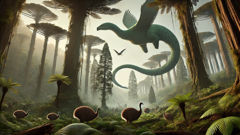
Legends say the Kumi was born of the oldest stone, emerging from the earth itself during the chaos of creation. Its form was vast—a lizard longer than a canoe, broad as a fallen tree, with claws sharp enough to peel bark from rimu and jaws that could crush ancient logs to splinters. The Kumi’s scales shimmered with green and blue, echoing the deep colors of the land it ruled. In some tales, the Kumi possessed a frill or crest that bristled when storms gathered, sensing the pulse of thunder before it broke. Others spoke of its breath—a warm, damp exhalation that could call forth the mists or send small creatures fleeing for cover.
Yet for all its power, the Kumi was no mindless predator. It kept a balance, moving through the forests with patience and purpose. When a landslide threatened to choke a stream or a tangle of brambles blocked the path of a river, it was said the Kumi would heave its massive body through the obstruction, restoring the natural flow. Birds followed in its wake, feeding on insects stirred from the undergrowth, while new plants took root where its tail swept aside leaf litter. The Kumi was both destroyer and creator—shaping the wild not by malice, but by a relentless, primal logic.
Some of the earliest birds and reptiles feared the Kumi, hiding when its shadow fell across a sunlit clearing. But others, like the nimble tuatara or the clever kiwi, learned to read its moods and keep their distance. On rare nights, when the moon hung low and silver over the land, the Kumi would slip to the banks of hidden lakes or curl among volcanic rocks warmed by the earth’s breath. Its presence was a sign to all that the old wildness still ruled, and that no creature could claim mastery over the land without respecting its oldest guardians.
So the world spun on in this fragile balance, with the Kumi as both sentinel and mystery—an untamed power whose name was seldom spoken, even by the taniwha themselves.
Arrival of the First People: Fear and Curiosity in a New World
The land changed forever with the coming of people. From distant islands, navigators guided by stars and ocean currents reached Aotearoa’s shores, bringing their wisdom, their dreams, and the first echoes of human voices. The ancestors of the Maori—those who would become tangata whenua, people of the land—set foot in a world alive with wonder and danger. Their arrival was not met with silence; the wilds watched and waited.
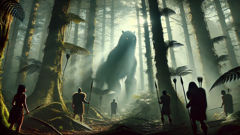
The Kumi, unseen but always near, felt the tremors of change in the earth. It listened as new fires crackled on riverbanks, as laughter and song rose through the ferns. Unlike other monsters, who fled or fought, the Kumi was patient. It watched the people build their first shelters from woven flax and weathered wood, saw them fashion tools from pounamu and bone, and observed how they learned to read the land’s moods.
But not all encounters were peaceful. Early hunters, seeking food in unfamiliar forests, sometimes vanished without a trace. Their companions whispered that they’d wandered too close to the Kumi’s lair or angered the old spirits. When footprints larger than a man’s head appeared in the mud or trees were found split and scarred, the people gathered by firelight to share stories—of the Kumi’s vast hunger, its power to vanish into mist, its eyes that glowed like burning resin in the night.
Some elders argued the Kumi was a warning: a sign that the newcomers must honor the rules of the wild, take only what was needed, and leave offerings where ancient stones marked the land’s bones. Others insisted the monster was a test, sent by the gods to see if people could survive not by force, but by understanding. Children listened wide-eyed, imagining a creature as long as the river and as old as the stars, lurking just beyond the reach of firelight.
Yet curiosity could not be quelled. One daring group—a band of young hunters led by a chief’s son named Tane—resolved to seek out the truth behind the legend. Armed with spears tipped in obsidian and hearts pounding with both fear and hope, they ventured into the deep forest. For days, they tracked clawed prints and listened for the low, rumbling breaths that seemed to shake the ferns. When at last they glimpsed the Kumi—a flash of scales in the half-light, a tremor in the earth—they did not strike. Instead, Tane lowered his spear and spoke aloud, promising that his people would learn from the land and treat all living things with respect.
The Kumi watched in silence, then slipped away into the shadows, leaving behind a trail of crushed leaves and a new sense of wonder. From that night on, the Kumi’s presence became less a threat and more a reminder—a living challenge to honor the wild, to find balance, and to remember that even monsters have their reasons.
The Test of Courage: The Day the Kumi Awoke
As generations passed, people settled deeper into Aotearoa’s valleys and hills. Villages grew at the forest’s edge; gardens flourished beneath the southern sky. Yet always, there lingered an awareness that the old guardians remained—unseen, but never absent. The stories of the Kumi became woven into song and proverb, a warning and a guide.
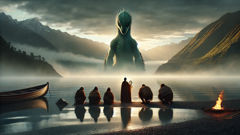
One year, after a harsh winter and a storm that uprooted trees and flooded the rivers, the people faced hardship. Crops failed. Fish grew scarce. In their struggle to survive, some forgot the old ways—felling sacred trees for firewood, hunting beyond their need, taking without thanks. The land, once generous, grew silent. The elders gathered and spoke of imbalance, remembering the ancient pacts.
It was then that the Kumi awoke in earnest. Villagers awoke to find enormous trails pressed into the earth, whole stands of bush flattened, and rivers churned to mud. At dusk, a deep roar—neither bird nor wind—echoed across the valleys. The bravest among them saw flashes of green and blue moving through the gloom. Fear swept through the people. Some pleaded with their gods; others blamed neighbors for failing in respect. The land itself seemed to turn against them.
Into this crisis stepped Hinewai, a young woman known for her clear voice and her patience with both children and elders. She believed that the Kumi’s anger was not blind rage, but a call to remember what had been forgotten. Gathering a group of friends, Hinewai set out to seek the Kumi and ask for forgiveness—not with weapons, but with gifts: woven cloaks, carved pendants, and food offerings from their meager stores.
They followed the signs: broken trees, claw marks on stone, the lingering scent of damp earth. For two days and nights, they journeyed through rain and fog, hearts heavy with fear but also hope. On the third dawn, they found the Kumi at the edge of a shrouded lake, its massive form coiled among rocks glazed with dew. Its eyes burned with an ancient intelligence, watching their every move.
Hinewai knelt at the water’s edge and spoke: not just for her people, but for all who lived on the land—the birds, the fish, even the old stones. She promised that her village would restore what was lost, replanting trees and caring for streams, sharing food with those in need. As she spoke, the Kumi listened. Its tail curled tighter; its breath steamed in the chill air. At last, it dipped its head—just once—in solemn acknowledgement. Then it slid into the water and vanished, leaving ripples that shimmered with morning light.
The people kept their promise. Forests returned, rivers ran clear, and birdsong filled the air once more. From that day, the legend of Hinewai’s courage spread throughout Aotearoa, a reminder that even in darkness, respect and understanding could restore the balance between people and the wild.
Conclusion
The legend of the Kumi endures—not just as a story of monsters or warning, but as a living thread woven through Aotearoa’s spirit. Though people have changed the land—planting crops, building homes, taming wild spaces—the memory of ancient guardians still shapes how the Maori see their world. The Kumi’s story is more than a tale of fear; it’s a reminder that nature’s power can be both fierce and wise, demanding respect from all who walk beneath the ferns and stars. Even now, deep in misty forests or beside silent lakes, some say they catch glimpses of a great shape slipping between trees or find scales shining like greenstone on riverbanks. Whether real or imagined, the Kumi remains a symbol—a guardian not just of the wilds, but of balance, humility, and the enduring relationship between people and the land. In every echo of birdsong and in every ripple across a still pond, the old legend lingers: Aotearoa was once home to giants, and their spirit lives on wherever respect and wonder dwell.

